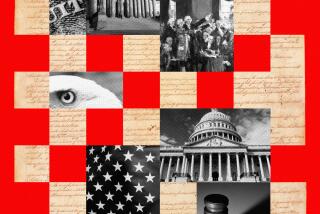Book Review : Constitution Is Celebrated With a Storyteller’s Gift
- Share via
Miracle at Philadelphia: The Story of the Constitutional Convention May to September 1787 by Catherine Drinker Bowen (Atlantic-Little, Brown: $18.95 hardcover, $8.95 paperback)
Having celebrated the bicentennial of the Declaration of Independence 10 years ago and the centennial of the Statue of Liberty last summer, the nation is about to embark on celebrating the 200th anniversary of the signing of the U.S. Constitution, which will occur Sept. 17.
This time, the outpouring of patriotic fervor may even evoke serious attention to the work being feted, for the Constitution is one of the most extraordinary political documents ever written. It was fashioned in Philadelphia during the summer of 1787 by several dozen men who somehow dreamed up a system of government that has nurtured the fairest, most democratic, most freedom-loving and wealthiest nation in history.
How the Constitution came to be written and how that system of government came into being is the subject of Catherine Drinker Bowen’s remarkable book, “Miracle at Philadelphia,” which was published 20 years ago and is being reissued in conjunction with the bicentennial festivities. If you read only one book on the Constitution in your life, this could be it.
Bowen combines a storyteller’s gift with the scholarship of a historian and brings to life both the people of the Constitutional Convention and the issues that they debated, which repeatedly threatened to doom their efforts to failure.
As Current as the News
Many of those issues seem as far removed from the 20th Century as if they had occurred in prehistoric times, while others are as current as today’s news. In two centuries, they haven’t gone away.
But even those issues that are long since settled--whether new states should be admitted to the union as equals of the original 13, for example, or whether the President should have a veto over acts of Congress--remind us that the entire structure was created from whole cloth. The Founding Fathers had nothing to guide them. They were creating a government unlike any that had come before.
Some historians of the Constitutional Convention have argued that the framers were motivated by economics. They were rich landowners, this argument goes, who were trying to protect their wealth and status.
Bowen will have none of it. Drawing heavily on the copious notes taken by James Madison and several others, she portrays the Founding Fathers as men driven by high principle who saw their hard-won independence threatened by squabbling among the states and who understood that they were inventing a new system for a young continent that would endure far into the future.
“Not the least surprising characteristic of the Federal Convention was that, contrary to the tradition of political assemblies, it let itself be swayed by men of thought and historical perspective,” Bowen writes.
Taking the Long View
She quotes John Rutledge of South Carolina, who told the convention, “As we are laying the foundation for a great empire, we ought to take a permanent view of the subject and not look at the present moment only.” And Madison himself, who said that their work would “decide forever the fate of republican government.” And Elbridge Gerry of Massachusetts (who would later give his name to the word gerrymander ), who reminded the delegates that “something must be done or we shall disappoint not only America but the whole world.”
At the same time, the framers had no wild-eyed faith in the wisdom of the people. Democracy was not their goal. They feared the people and spent much time devising structures to insulate the new government from their passions. The Electoral College is a product of that concern. So was the election of United States senators by the state legislatures, which was the system until the 17th Amendment was adopted in 1913.
But just as they feared the masses, so, too, did the framers fear the tyranny of an absolute ruler. They had all lived as subjects of King George III, and they sought institutional structures that would prevent America from being governed by another like him.
They debated whether the House of Representatives should serve one-year terms or three-year terms. Those who favored one year said frequent elections would be a bulwark against tyranny. Those who favored three years said it would take that long for the Representatives to learn the problems of the whole country. The framers compromised on two-year terms.
The Great Compromise
Compromise was the watchword of the convention in many matters, including the Great Compromise itself, which solved the problem that had haunted the convention throughout that long, hot summer: how to reconcile the demand of the 10 small states that they have equal representation in Congress with the large ones and of the three large states that they have representation in proportion to their populations and wealth.
The solution was to give all states equal representation in the Senate but to have proportional representation in the House. Bowen describes how this compromise was suggested several times during the convention before it was actually agreed to. Novel ideas are rarely accepted they first time around. They take time to sink in.
Thomas Jefferson and John Adams were out of the country during the convention, but the other big names of the Revolutionary period were there. George Washington presided silently over the meetings, which were addressed by Benjamin Franklin and Alexander Hamilton.
But when the convention completed its work, it was not at all clear that the country would accept this new Constitution to replace the Articles of Confederation, and the debates of Philadelphia were repeated in all 13 states. There were Federalists and there were anti-Federalists, and they each gave as good as they got.
The Constitution was adopted, but by the barest of margins, and only after the states demanded that a Bill of Rights be attached to the basic document. The convention had discussed putting a Bill of Rights into their version of the Constitution but had decided that it was not necessary.
“Miracle at Philadelphia” is a book for anyone interested in history, democracy, political science or law. Nowadays it is fashionable in some quarters to speak of the “original intent” of the framers and to argue that contemporary constitutional issues should be decided in concert with what the Founding Fathers envisioned.
But Bowen’s book clearly demonstrates that the founders were of many minds. One might ask, “The original intent of which founders?” All we can say is that they all wanted a government that would serve the best interests of 3 1/2 million people who lived along the Atlantic Coast.
The wonder is that they created one, and the miracle is that it still serves more than 241 million people from the Atlantic to the Pacific and is the envy of millions more around the world.
More to Read
Sign up for our Book Club newsletter
Get the latest news, events and more from the Los Angeles Times Book Club, and help us get L.A. reading and talking.
You may occasionally receive promotional content from the Los Angeles Times.










